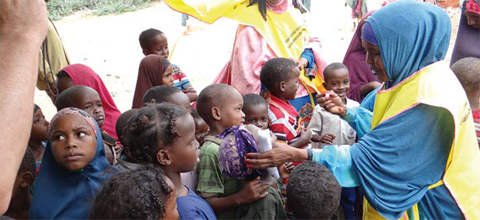Photo: Children receiving the polio vaccine in Somalia.
Despite violence and abuse in Somalia, we wish to report some successes with disease surveillance.
We have read with total understanding, but deep sadness the pull out of Médecins Sans Frontières (MSF) from Somalia. Since the 2011 famine declaration, there has been an exodus of health workers and agencies, and MSF is the latest to announce its exit. [1,2] A governance void has left much of the healthcare coordination to United Nations agencies.
However, despite this void, disease surveillance data are critical during humanitarian emergencies when mortality and morbidity are highest. Effective disease control relies on accurate disease burden information. However, collecting health data has remained a major challenge in Somalia. Before the famine, five surveillance networks, including an early warning and integrated disease system, were functioning inadequately, in various regions of the country. New systems were established alongside existing ones resulting in overlap or redundancy. In October 2011, the Centers for Disease Control and Prevention (CDC) evaluated two of the systems because of the urgent need for quality health data to inform humanitarian famine response. The evaluation found fabricated health facilities from Somali contacts; untrained health workers; poor data quality; and minimal analytic interpretation. Despite these limitations, stakeholders appreciated these systems’ ability to provide health data. The evaluation recommended consolidating multiple surveillance systems into a single, simplified system. The result was a revised Communicable Disease Surveillance and Response (CSR) system.
In response to underperforming health information systems during emergencies, the World Health Organization (WHO) established the Early Warning and Response Network (EWARN) to rapidly detect outbreaks and link detection with verification and response. Between 1999 and 2008, EWARN systems were established throughout Africa and Asia, with little systematic implementation. Despite shared attributes, a 2009 review of multiple EWARN systems revealed fundamental differences and little standardization across systems, similar to problems found during the Somali surveillance evaluation. This led to the EWARN operational guidelines. [3] In 2010, Haiti and Pakistan each suffered natural disasters with major population displacements. As a result, an EWARN system was implemented in Haiti and the operational guidelines were piloted in Pakistan. [4,5] Lessons learned from these emergencies indicated the guidelines were insufficient when limited resources, poor coordination, and competing priorities were commonplace. [6] More comprehensive, practical guidance focusing on EWARN implementation during an emergency, emphasising improved data quality was needed. Therefore, the 2012 WHO EWARN implementation guidelines were written and included: [7]
- Fewer priority diseases of epidemic-potential only, causing severe morbidity and high mortality, meeting International Health Regulation requirements, and having reliable syndrome-based case definitions and interventions.
- Fewer, reliable, representative health facilities providing weekly data (alert notification remained exhaustive).
- Standardised reporting forms and mechanisms.
- Ongoing training of clinical and surveillance workers.
- Enhanced monitoring and evaluation (M&E).
These guidelines were actualised with the revised Somali CSR. CSR was reduced from 16 to 9 epidemic-potential conditions (e.g. cholera, acute flaccid paralysis [AFP]) and less than 150 health facilities, thereby easing the reporting burden. WHO with CDC developed a weekly reporting form and schedule, recruited staff at the zonal and regional levels, initiated training of 20 regional staff, and began monitoring data quality.
Both strengths and challenges exist with revised Somali CSR implementation. Continued insecurity and poor access to areas controlled by insurgents have impeded progress in parts of Central and Southern Somalia; staff have risked their lives by reporting. Zonal government restrictions have hindered trainings and monitoring and evaluation activities. A lengthy recruitment process has negatively impacted staff hiring and outbreak investigation at headquarters’ level, limiting the ability for sufficient overall programme management. Donors are more inclined to provide medicines and supplies than to provide staff salaries needed to ensure proper CSR implementation. Despite these challenges, completeness and timeliness of data reporting is nearly 100% in all four zones, an epidemiological bulletin is produced regularly, and CSR picked up the two reported AFP cases (epidemiological weeks 15/16, April 8–21, 2013) since 2007 that subsequently marked the beginning of a polio outbreak and launched international efforts to contain its spread. Even in a war-torn region, surveillance can aid public health action. [8]
The findings and conclusions in this report are those of the authors and do not necessarily represent the official position of the Centers for Disease Control and Prevention.
References:
1. Centers for Disease Control and Prevention. Notes from the field: Malnutrition and mortality—southern Somalia, July 2011. MMWR 2011;60(30):1026-27
2. IRIN. Somalia: Al-Shabab ban on agencies threatens aid, 28 November 2011.
4. Centers for Disease Control and Prevention. Early warning disease surveillance after a flood emergency—Pakistan, 2010. MMWR 2012;61(49):1002-7.
5. Centers for Disease Control and Prevention. Rapid establishment of an internally displaced persons disease surveillance system after an earthquake—Haiti, 2010. MMWR 2010;59(30):939-45.
7. World Health Organization. Outbreak surveillance and response in humanitarian emergencies,
WHO guidelines for EWARN implementation, 2012.
8. Centers for Disease Control and Prevention. Notes from the field: Outbreak of poliomyelitis—Somalia and Kenya, May 2013. MMWR 2013;62(23):484.
Competing interests: None declared
Susan T Cookson, Medical Officer, US Centers for Disease Control and Prevention, 1600 Clifton Rd, NE.
Antony Ajanga, Marthe Everard, Ghulam R Popal (World Health Organization Somalia Office, Nairobi, Kenya), Kevin R Clarke, Farah Husain (US CDC)
See also:

